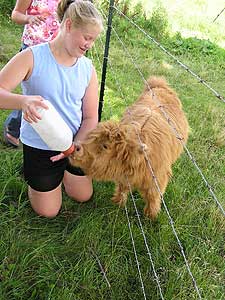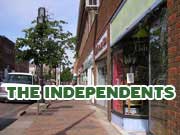| The Independents |
Organic partners
August 16, 2004
 |
| A neighbor feeds Sir Herman, a calf at Beaver Creek Ranch. Herman is a Scottish Highland bull. (MPR Photo/Cynthia Johnson) |
Duluth, Minn. — About a year ago, chef Kirk Bratrud moved from the Twin Cities to Superior, Wisconsin. He and his family built a small restaurant on the edge of Lake Superior. It's called The Boathouse, and it features fresh-caught fish, local vegetables, and Scottish Highland beef.
"It's a very lean, but tender piece of meat," Bratrud says. "It has a good deal of flavor, not remarkably different from most beef. But it has a slightly peppery flavor, something approaching elk, but more like beef."
Bratrud says his customers love Scottish Highland beef.
 | |||
"Our problem with beef, however, is that we wish more of it was available."
He has to take it off the menu when he runs out. Only three farmers in the area raise Scottish Highland beef. One of them is Doug Anderson. Anderson owns Beaver Creek Ranch near Grantsburg, Wisconsin.
He agrees the Highland beef has a special taste, and he says Highlands offer plenty of advantages to a farmer.
"It seems to be a sweeter meat," Anderson says. "There is no waste in the animal, as the fat is on the back of the animal rather than a heavy marbling. And our animals are not grained at all. We don't even have a feedlot. When we're ready to take an animal to processing, it will just be picked out of the herd, put in a trailer, and go for processing." Because the animals live outside and don't spend time in a feedlot, they never get treated with antibiotics.
Anderson grew up on a farm, then had a career in law enforcement. When he retired, he decided to move back to the farm.
 | |||
"So many things had changed in the new farming techniques that I didn't know about, that I came back to farm in the way I knew how to farm," Anderson says. "And that is without chemicals, with a small tractor. I couldn't afford sprayers; I didn't know a thing about hydraulics."
Anderson's old-fashioned methods turned out to be profitable in the newly developing organic market.
"We farmed organically back then -- we just didn't have a word for it," he says.
Anderson has nearly 50 Highlands. Some are half Highland and half Red Angus. The herd is growing, but it takes time to raise cattle. About 20 steers are ready for market each year.
Anderson also raises organic soybeans to sell in Japan, and vegetables to sell to local co-ops. So he doesn't want to devote any more land to pasture.
 | |||
But when he started selling to The Boathouse in Superior, he realized there was a bigger market out there than he could supply. So he's trying to recruit other farmers to raise Scottish Highland cattle. He has sold brood cows and bulls to three neighbors. They're still building up their herds. But Anderson says when their animals are ready to butcher, he'll put them in touch with The Boathouse and his other markets.
Three miles away, another organic farm has a different specialty -- aged cheese made from sheep milk. Mary and David Falk have about 200 sheep. They milk half of them, and make about two dozen cheeses twice a week.
David Falk built the aging cave. It's a concrete silo, built into a hillside. Inside, it's dark and cool. The room is filled with nearly 1,000 cheeses, resting on cedar planks. Mary Falk says she's fallen in love with the different molds that grow on the rinds of the cheese.
"We've got a gold mold, there's a mauve-colored mold, a blue mold -- violet, there's a gray, there's a soft green," she says, stroking a cheese. "So each one of those little molds adds a a hint of flavor and complexity to the cheese."
 | |||
The Falks have been breeding sheep and making cheese for 18 years. They used to sell their Love Tree cheeses to restaurants in New York and San Francisco. But after the terrorist attacks three years ago, the orders dropped off suddenly, and the Falks started selling at the farmer's market in St. Paul.
Now, they don't have enough cheese to satisfy their retail customers, as well as supply restaurants and cheese shops.
Mary Falk has tried several ways of boosting her production. She tried buying sheep milk from other farmers, but it didn't taste the same as the milk produced by her own flock. So she tried to recruit farmers to buy some of her sheep and sell her the milk. A couple of neighbors tried it, but quit after awhile.
Her latest idea is what she calls the Love Tree Farm extended label program.
 | |||
"What Love Tree is known for is our grass-based milk, our own organic standards, high quality food, and flavor," she says. "And if somebody is making a high quality cheese on their farm, and doing it off grass-based milk, we are willing to put that into our market for them. We would age the cheese here. And to get them started in marketing, we would put the Lovetree label on their cheese, like, 'Love Tree introducing Johnny Smith.'"
Falk says it would give customers a chance to learn about new cheeses from a name they trust, and it would give new farmers access to an established market.
Quite a few groups around the country are trying creative ways of getting local farmers together with restaurants and consumers. Amy Trubek runs Vermont Fresh, a group that's trying to preserve the small farms Vermont is famous for. She says chefs, like Kirk Bratrud at The Boathouse, are the best customers.
"Chefs are really interested in high quality ingredients, and they really like flavor, good-flavored food," Trubek says. "And they see that buying locally means you're going to get better food, and support your community at the same time."
It takes time and ingenuity to create good matches between local producers and local consumers. Amy Trubek says because we've been living with a national, even global food market, a lot of the local infrastructure -- like slaughterhouses and farm stands -- has faded away. But she says some consumers are beginning to ask for local food at restaurants and grocery stores.
|
News Headlines
|
Related Subjects
|

